
Piet Mondrian (March 1872 – 1 February 1944) is a Dutch artist, a famous pioneer of 20th-century abstract art. He is also known as one of the originators of the “De Stijl (Neoplasticism)” movement.
Life
- In 1872, Mondriaan was born in Amersfoort in the Netherlands. His father, Pieter Cornelius Mondriaan, was a drawing teacher and the family moved to Winterswijk when his father became a headteacher at a local primary school. His uncle, Fritz Mondriaan was a pupil of Willem Maris of the Hague School of artists. Therefore, Mondriaan was introduced to art since he was a kid.
- Mondriaan accepted strict Protestant training and determined to be an artist. However, he first obtained a degree in education because of the insistence of his family.
- In 1892, instead of looking for a teaching position, Mondriaan entered and intermittently studied at the Academy for Fine Art in Amsterdam. He became a member of the art society Kunstliefde (“Art Lovers”) in Utrecht, where his first paintings were exhibited in 1893. Then he exhibited the second time in 1897.
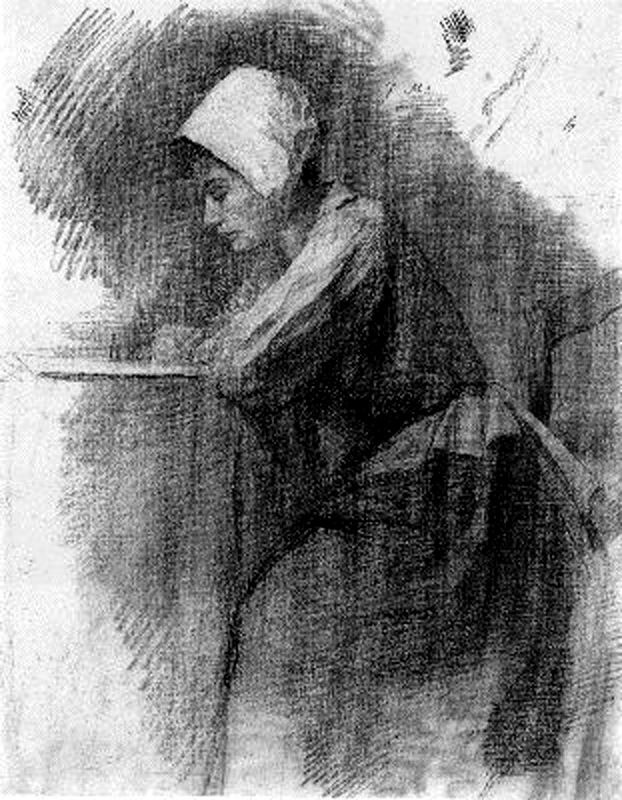
- In 1903 Mondriaan visited a friend in Brabant, Belgium. It is believed that the calm beauty and the clean lines of the landscape largely influence his art style.
- In 1905, he returned to Amsterdam and his art had visibly changed to focus more on the compositional structure than the traditional picturesque values of light and shade.
- In 1907 Amsterdam sponsored the Quadrennial Exhibition, featuring a lot of Post-Impressionists such as Kees van Dongen, Otto van Rees, and Jan Sluijters. Their influence of daring using colour soonly reflected in Mondrian’s Red Cloud, a rapidly executed sketch from 1907.

- His new style was reinforced by his acquaintance with the Dutch artist Jan Toorop, who led the Dutch Luminist movement.
- In 1908, Mondriaan became interested in the ideas of Theosophy and he joined the Dutch branch of the Theosophical Society in 1909.
- In 1911, in the Moderne Kunstkring exhibition of Cubism in Amsterdam, he saw for the first time the early Cubist works of Pablo Picasso. Almost immediately the concept of Cubism integrated into his work, for example, the different two versions of his Still Life with Gingerpot.
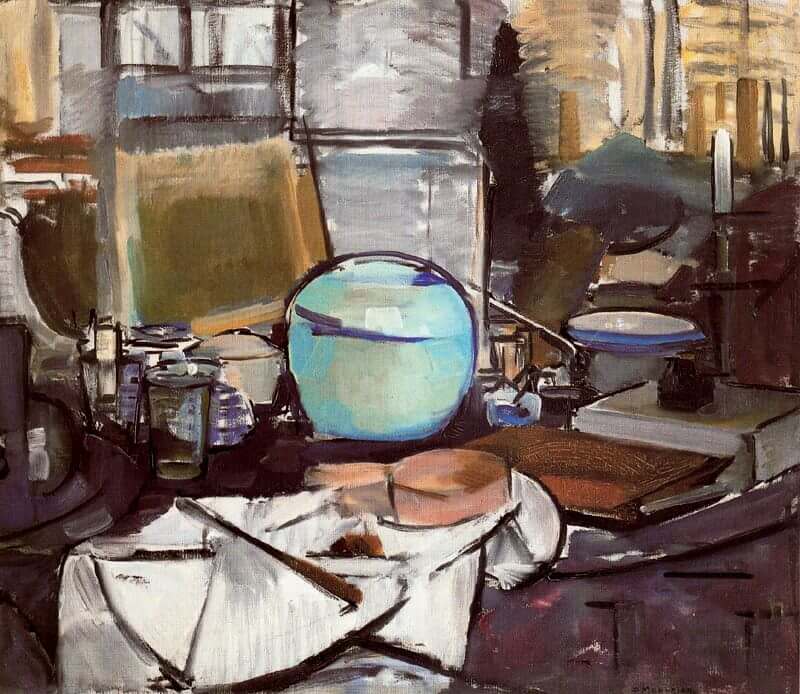
Piet Mondriaan, The Still Life with Gingerpot I, 1911 
Piet Mondrian, The Still Life with Gingerpot II , 1912
- At the beginning of 1912, Mondriaan moved to Paris. He changed his name to “Mondrian” that dropping an ‘a’ from “Mondriaan”, to emphasize his departure from the Netherlands and his integration within the Parisian avant-garde.
- In the summer of 1914 Mondrian returned to the Netherlands to visit his father, who was seriously ill, and the outbreak of World War I prevented him from returning to Paris. During this period, he stayed at the Laren artists’ community, where he met Bart van der Leck and Theo van Doesburg, who were both exploring their own abstract art.
- In 1917, with other artists, Mondrian and Van Doesburg founded the art periodical and the movement of De Stijl. In this magazine, Mondrian first published essays defining his theory, which he called neoplasticism.
- In 1918, Mondrian went back to Paris.
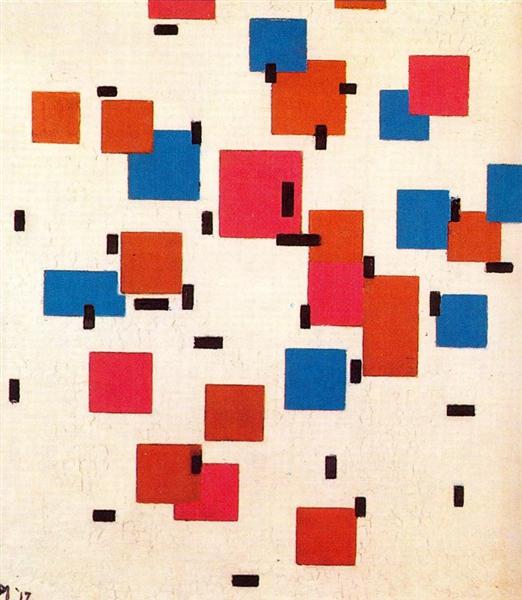
- In 1924, Piet Mondrian decided to leave the group because of the disagreement with Van Doesburg. Although they were reconciled when they accidentally met in a café in Paris in 1929.
- In 1926, Katherine Dreier, co-founder of New York City’s Society of Independent Artists, visited Piet Mondrian’s studio in Paris and acquired his Tableau I. This was then manifested during an exhibition in the Brooklyn Museum–the first major exhibition of modern art in America since the Armory Show.
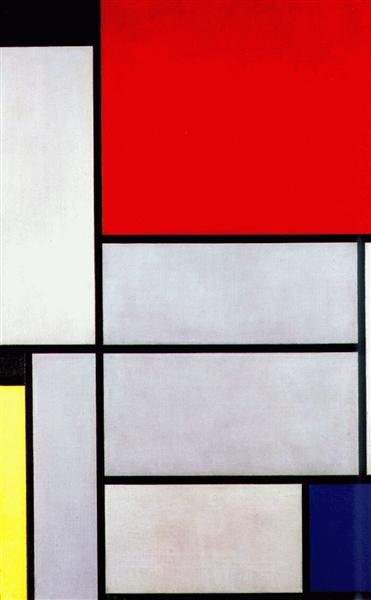
- In 1931, Piet Mondrian joined the Abstraction- Creation line, which was more open to new styles, to new techniques, and to a difference in styles of work, which the artists would create.
- In 1938, due to the advancing fascism, Mondrian moved to London.
- In 1940, after the Netherlands was invaded and Paris fell, he left London for Manhattan, where he would remain until his death.
- On 1 February 1944, Piet Mondrian died of pneumonia. He was interred at the Cypress Hills Cemetery in Brooklyn, New York.
Style
Because of the influence of his father and uncle, Mondrian’s early paintings are closely connected with realism or impressionism. He always painted the landscape and still-life subjects around Amsterdam by using subdued hues and lighting effects.
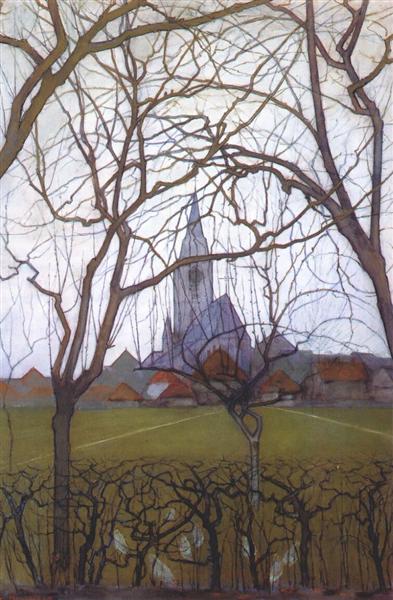
This solid foundation of technique and cognition even still reflected in Mondrian’s beginning of twenty-century. For example, in his Mill of Heeswijk Sun, although his style had some kind of subtle change, the traces of realism can still be found in this painting.
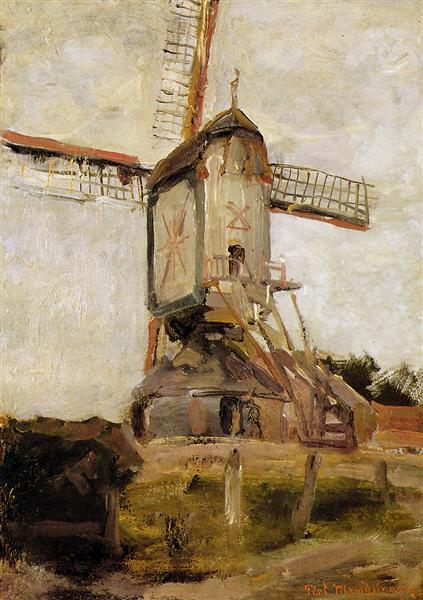
However, in contrast, the later Post-Impressionists Arts obviously had a much more powerful impact on Mondrian’s style.
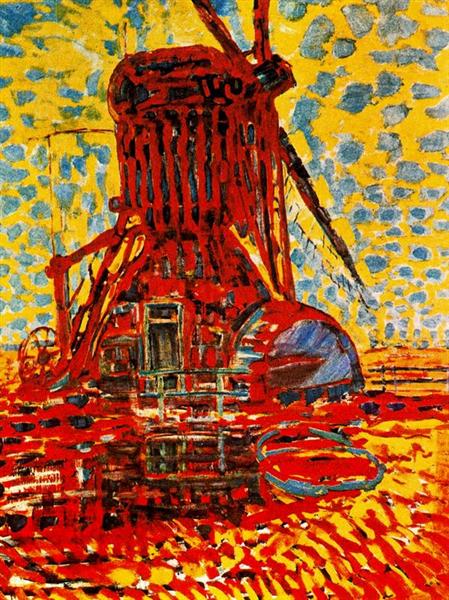
Mondrian’s colour became not as cautious as the past, his painting seems to infuse a powerful soul that told the story behind the image.
Continue to the constant style change in the first decade of twenty-century. Mondrian’s arts developed once again when he had contacted to the cubism.
This time, Mondrian got rid of the shackles of his past. The shapes of the objects in his paintings were started to be abstracted. The early influence of his family was almost disappeared in his arts. His structures became much more simple and the entirety looks more harmonic.
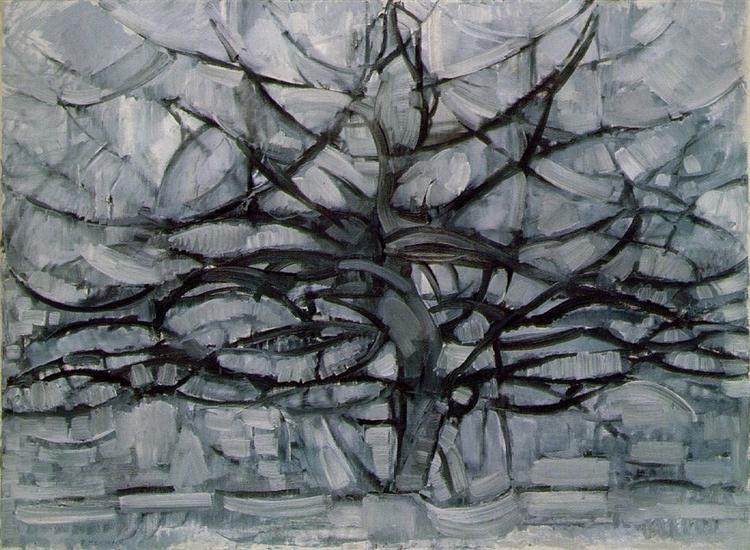
However, Mondrian who the contemporary society truly familiar with is after his meeting with Van Doesburg and Van der Leck. It could say that their abstract arts became the foundation of Mondrian’s future works to some extent. Especially, Van der Leck’s use of only primary colours in his art greatly influenced Mondrian.
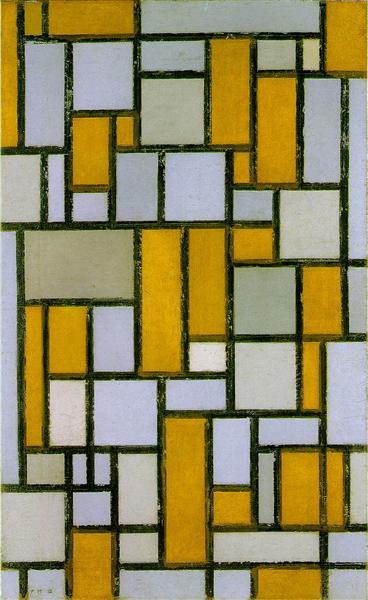
At the initial creation of the abstract paintings, Mondrian surpassed his limit of cognition but did not really find his own way. His works are more like the experiments, that each style had a subtle difference with another.
Until the 1920s, Mondrian finally confirmed his art style. The iconic combination of straight lines with the colours of red, yellow, blue, black, and white was determined.
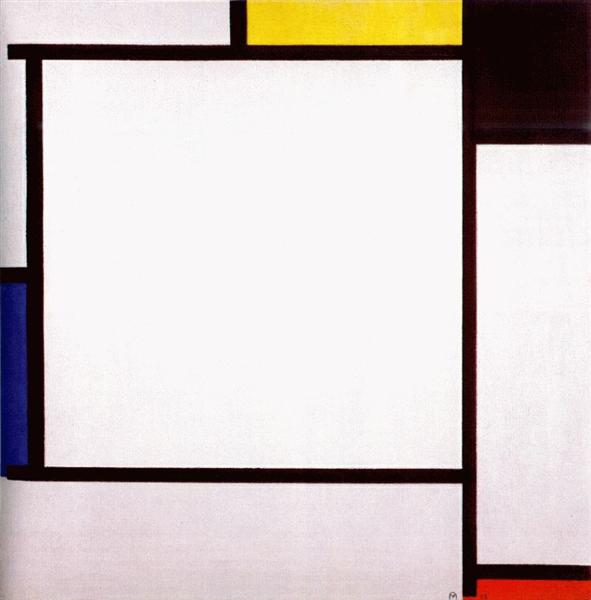
This simple abstract harmony remained the same for a long time, until Mondrian’s last few years, his works raised to the new heights. The lines were not only black and the complexity of colours had an obvious development. Mondrian’s harmony became much more dynamic but not only the visual balance in the first impression.
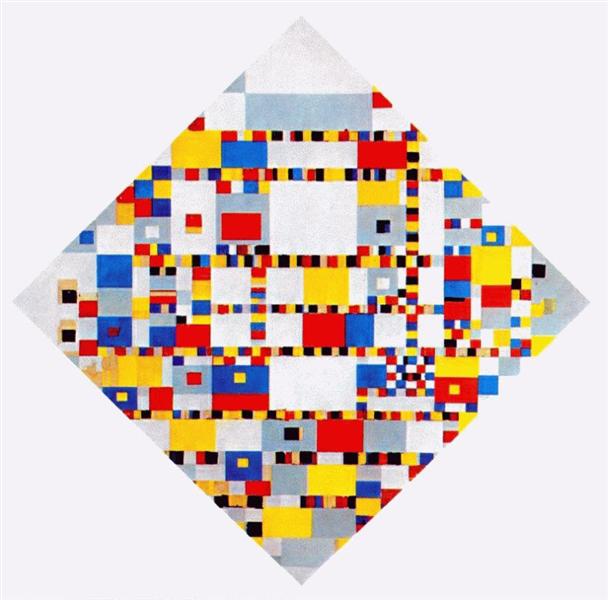
Personal Opinion
Piet Mondrian is an artist who is good at learning new stuff and having self-reflection. No matter realism, impressionism, cubism or abstractionism, he can always absorb their essences and improve his own art understanding. In my opinion, artists’ pursuits are breakthrough the current limit of human cognition and rising human spirit into a higher level, so artists must first surpass themselves’ stereotyped frame. However, Mondrian was a miraculous genius in pushing the limits of self. He revolutionarily transformed his style again and again by endlessly studying and pursuing his spiritual harmony. Even until the end of his life, I cannot imagine how he could further develop and evolve his pure abstract arts into such vigorously complicated colour combinations. He really did that changed the world by his art and redefined social aesthetics.
I like the harmony so much in his works. Mondrian’s all works are well balanced by his spiritual pursuit. From the earliest subdued hue value to the lastest primary colour, Mondrian’s works are just like a precise balance of light. They can always guide audiences’ eyes to easily find a comfortable way to look through the whole images. This must the result of his long-term research in theology and philosophy that the high-level understanding of the human spiritual world provided him with a significant background behind his arts.
References
https://www.piet-mondrian.org/ https://www.theartstory.org/movement/de-stijl/ https://www.wikiart.org/en/piet-mondrian/girl-writing-1895 https://www.piet-mondrian.org/the-red-cloud.jsp#prettyPhoto https://www.wikiart.org/en/piet-mondrian/composition-in-color-a-1917 https://www.wikiart.org/en/piet-mondrian/avond-evening-the-red-tree-1910 https://www.wikiart.org/en/piet-mondrian/composition-2-1922 https://www.wikiart.org/en/piet-mondrian/the-gray-tree-1911 https://www.britannica.com/biography/Piet-Mondrian/Cubist-period-in-Paris https://www.wikiart.org/en/piet-mondrian/mill-of-heeswijk-sun https://www.wikiart.org/en/piet-mondrian/village-church-1898 https://www.wikiart.org/en/piet-mondrian/tableau-i-1921 https://www.piet-mondrian.org/the-still-life-with-gingerpot-2.jsp https://www.piet-mondrian.org/the-still-life-with-gingerpot-1.jsp#prettyPhoto https://en.wikipedia.org/wiki/Jan_Toorop https://kinderart.com/blog/mondrian/ https://www.piet-mondrian.org/the-still-life-with-gingerpot-2.jsp https://www.piet-mondrian.org/the-still-life-with-gingerpot-1.jsp#prettyPhoto https://en.wikipedia.org/wiki/Jan_Toorop https://kinderart.com/blog/mondrian/